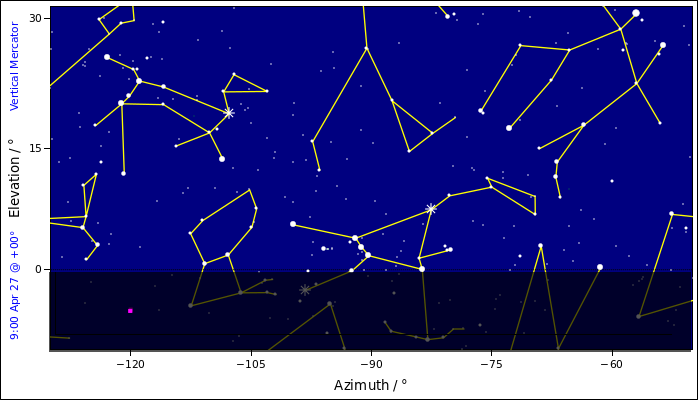
Figure 1: Orion Straddling The Horizon
Consider two simple facts, and the inescapable conclusion:
Those two observed facts tell us the earth cannot possibly be flat. Here’s the reasoning:
| In reality, the earth is round, so the horizon depends on where you stand, as shown in figure 2. | If the earth were flat, there would be a well-established notion of horizontal, which would be the same for everybody: a flat plane parallel to the surface of the earth. |
| When a star is below such a flat plane, it is below for everybody. When it’s above, it’s above for everybody. It can’t possibly be completely above and completely below at the same time. |
Let’s look at how Orion moves.
We start with figure 3. Orion is in the center. The star Bellatrix is 15 degrees above the horizon. The star Betelgeuse is 7½ degrees higher. Let’s call this the 8:00 situation.3
Figure 4 shows the 8:20 situation. Bellatrix is now only 10 degrees above the horizon. Once again Betelgeuse is 7½ degrees higher.
Figure 5 shows the 8:40 situation. Bellatrix is now only 5 degrees above the horizon. Unsurprisingly, Betelgeuse is 7½ degrees higher.
Figure 6 shows the 9:00 situation. Bellatrix is just barely above the horizon. Unsurprisingly, Betelgeuse is 7½ degrees higher.
Figure 6 shows the 9:00 situation, which is the punch line. Bellatrix is not visible, because it is below the horizon. Even so, we know exactly where it is, because Betelgeuse is visible 2½ degrees above the horizon, and Bellatrix is 7½ degrees below that, as always.
Let’s be clear: The stars we can see bear witness to the stars we can’t see.
Note: The diagrams in this section correspond to a viewpoint on the equator.
The reason for calling attention to constellations is discussed in appendix A.
Here’s a video of Orion setting across the western horizon.
In the video, the viewpoint is at 28∘ south latitude, so the geometry is a little different from the diagram. The stars are still moving across the sky at a rate of 1 degree every 4 minutes; the only difference is that they are moving along a slight diagonal. In any case, the punch line is the same: The constellation sets by crossing the horizon. The stars we see bear witness to the stars we can’t see.
Don’t try to tell me that the stars aren’t really below the horizon, and only appear to be so due to distortion. There is always "some" small distortion, but it so small that it is undetectable in the video. It is utterly irrelevant to this discussion. The fact is, the stars move across the sky like clockwork. The constellations maintain their size and shape as the rise, cross the sky, and set.
Actually it’s ironic to say that the stars move like clockwork. For thousands of years, if you wanted to check the accuracy of your clock, you checked it against the stars, which are far more accurate than any manmade clock ever made, until ultra-fancy atomic clocks came on the scene in the 1950s.
It cracks me up when some flatnik asks "Where are the stars?". The answer is, they’re in the sky. You should take a look some time. Watch the stars as they set below the horizon.
"Where are the stars?" You’ve got to be kidding. We know where the stars are. The Hipparcos catalog contains position data for roughly 118,000 stars, including all the stars you can see with the unaided eye, or even a modest-sized telescope. In nearly all cases the position is known very accurately, better than a millionth of a degree, a million times more accurately than you could judge by eye. Spare me the atmospheric blah refraction blah fisheye blah blah. We know where the stars are. https://www.cosmos.esa.int/web/hipparcos/catalogue-summary
Constellations are artificial and arbitrary and in some sense imaginary, but they serve a very real purpose: They are a way of visualizing and remembering the geometrical relationships among the stars. The stars and their relationships are entirely real.
Here’s why I recommend observing constellations rather than isolated stars, the sun, or the moon, especially for beginners:
It is perfectly OK to watch the moon rise or set; it’s just harder to draw conclusions from what you see. Any phase of the moon will do, provided it’s not too close to new.
In each of the diagrams in section 2, near the lower-left corner there is a small magenta square. It is half a degree on a side. The disk of the sun or moon would fit snugly in that square. You can see that it’s really tiny compared to Orion. Therefore you might want to use a telescope, or a camera with a long lens, with a tripod. You have to take care with the timing and aiming. It also helps to take a series of pictures, with timestamps. That’s because the punch line is the same: The pictures of what you can see bear witness to what you can’t see.
Here are a few simple suggestions that may enhance your stargazing experience.
It’s not very bright, but for stargazing you don’t need it to be very bright.
Double-click or swipe the screen to turn it on and off.